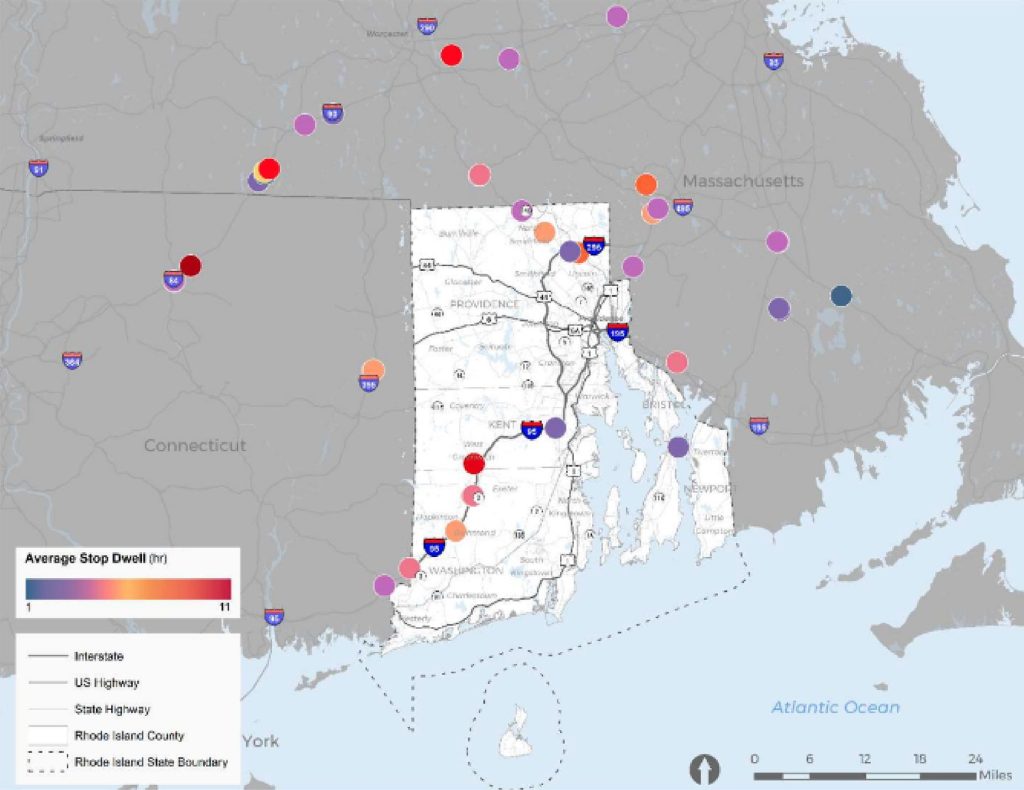
Creating next-gen state freight plans
A partner success story of how a combined commodity flow database from Altitude by Geotab and S&P Global helped WSP develop an advanced state freight plan for Rhode Island.
The challenge:
Accessing timely data for state freight planning
When Rhode Island requested proposals to help conduct analyses for their state freight plan, WSP responded, wanting to bring something special to the table. Though the state might be smaller in geographic size, its traffic networks, including the I-95 highway, are heavily traversed and have a significant impact on freight movement across the U.S. That’s why WSP knew that Rhode Island needed to capture the most accurate, up-to-date commodity flow data to understand exactly how their road networks were being used to facilitate goods movement.
The COVID-19 pandemic led to significant changes in freight movement, from the restructuring of supply chains to shifts in retail and consumer behavior. In 2022, Rhode Island was interested in developing the most accurate view of how freight moves through its highways, accounting for the impacts of the pandemic.
To address this need, WSP brought in S&P Global, the creators of the commodity flow tracking data and forecasting tool Transearch. While the Transearch database represents the gold standard in commodity flow information, the latest version available at the time only included pre-pandemic data. Bringing in Altitude by Geotab data of commercial trucking in 2021 and 2022 allowed S&P Global to update its Transearch database and develop the first-in-the-nation estimate of commodity flows post-pandemic.
The solution:
S&P Global unites with Altitude by Geotab to build a commodity flow database
Transearch can forecast commodity flow based on world-leading established modeling but uses a historical snapshot to connect the dots for future commodity flow. It would require more recent data to dive into accurate analyses of how Rhode Island traffic networks were being used for freight movement.
Near real-time data is one cornerstone of the Altitude by Geotab offering and the Altitude platform that allows users to slice and dice contextualized transportation analytics. Powered by deep and scalable connected-vehicle data, insights from millions of trips help users understand the where and the why of fleet and trucking movements.
Using near-real-time deidentified data collected from its parent Geotab, the market leader in freight telematics, Altitude by Geotab can accurately paint a picture of commercial vehicle movement and capture the context behind it. Geotab ITS collects data from over 20% of heavy-duty trucking in the State of Rhode Island with strong correlations to counting stations within the Federal Highway Administration (FHWA),
For this project, Altitude by Geotab provided up-to-date information on traffic flow across and into Rhode Island for building a more comprehensive state freight plan. With Altitude by Geotab, users can distinguish commercial vehicle activity and vehicle type, meaning that heavy-duty trucking could be classified separately from medium-duty or even light-duty commercial vehicles.
Below are the observations made by the team of commercial truck trips from 4/1/2021 to 4/30/2022 across Rhode Island, broken down by origin county, industry and mileage:

Observed trip counts by truck class in major Rhode Island cities

Commercial Heavy-duty truck trips are broken down by industry

VMT by truck class
Transearch typically tracks annual tonnages of trucking to convert those numbers into an estimate of the number of truck trips in a given region. This is done using commodity average payload factors, which until now had been predominantly based on heavy-duty trucks.
“Transearch modeling had been biased towards heavy-duty commercial vehicles. Altitude data is uniquely suited to distinguish between heavy-duty, medium-duty and light-duty, so we recalibrated our modeling considering that mix of vehicles allowing for more accuracy in estimated trips,” said Paul Ciannavei, Senior Trade Consultant at S&P Global.
The combined Transearch and Altitude by Geotab database classifies commercial vehicles by type, allowing the team to identify over 35% more truck trips in Rhode Island after reducing the average truck payload by about 20%.

The recency of Altitude by Geotab’s data and the ability to classify the data by the type of trucking activity addressed a real gap in the market and, when combined with Transearch’s commodity market information, becomes a real game-changer for building out more accurate state freight plans. Rhode Island specifically wanted to look at traffic across the state and where freight flows were coming from into the state. The combined commodity flow database gave more visibility for Rhode Island into all freight activity to and through the state.

Changes across transportation patterns and technology are rapid, so accessing the latest data figures goes a long way in keeping pace with development. This commodity flow database becomes a powerful tool for planners in building advanced state freight plans that span economic development and infrastructure projects to serve the needs of their community best and keep freight moving.
More accurate state freight plans help inform infrastructure projects like assessing road safety and where maintenance needs to be prioritized. “We’re shedding light on how road networks are truly being used and linking the operational management of roads with the strategic planning side of things,” continued Ciannevei. “Now planners can make better-informed decisions for capital investments like bridges and highway repair while also presenting the facts to gain buy-in from other stakeholders.”
The impact:
Accuracy and granularity in commercial truck parking activity
The team at WSP has extensive experience in knowing what commodity flows should look like to lead the validation of the combined database. They took no time figuring out the right queries to get the data Rhode Island was looking for and correlated the data to estimations with high confidence in the numbers. But the data story wasn’t done there.
Another component of state freight plans is looking at truck parking and where additional infrastructure might be needed to create safer trucking environments for drivers and other motorists on the highway. WSP realized the accuracy and granularity of Altitude by Geotab data could also play an important role in helping planners identify truck parking needs across the state.

Location and volume of parking across Rhode Island broken down by truck class (HDT).
https://planning.ri.gov/planning-areas/transportation/freight-planning/2016-freight-and-goods-movement-plan
Critical questions like if there are enough truck parking facilities to accommodate driver schedules or exactly where, when and how long trucks were parking in Rhode Island could now be answered with deeper insight into commercial vehicle behavior. The database highlights popular routes taken into the state and where exactly trucks are parking when coming in from adjacent states like Massachusetts or Connecticut.
Rhode Island’s Department of Administration, Supervising Planner Joshua O’Neill noted they gained insights that characterized truck parting activity that allowed them to make recommendations that best serve the trucking industry’s needs around the state.
“Rhode Island utilized both Geotab ITS and S&P datasets to attain a long-term freight forecast that captured the disruptions of the Covid-19 Pandemic and the expected near doubling of freight volume over the forecast period to 2050”, commented O’Neill. “These datasets also allowed us to gain a clear picture of the increasing need for more public truck parking spaces for the expected increase in truck volumes on our roadways and allow the state to make informed decisions about how we allocate our resources for future improvements to our road and bridge infrastructure through our State Transportation Improvement Program. With this data and the recommendations made by WSP, the State of Rhode Island can more efficiently allocate resources to improve the efficiency of our freight transportation system along the corridors where the highest freight volume is expected over the next two decades.”
There is a higher degree of detail now possible in truck movements than available with other data sources. Distinguishing between light- or medium-duty vehicles and heavy-duty trucks, analysts can also look into why certain commercial vehicles take particular routes or stop at different locations.
“We knew we had something special with this database from S&P Global and Geotab ITS. We’ve essentially developed a first-in-the-nation post-pandemic freight flow analysis that gives Rhode Island a deep dive into regional trucking activity and parking for their state.”
Sebastian Guerrero, AVP of Freight and Logistics with WSP

Average stop time of heavy-duty trucks across Rhode Island .
https://planning.ri.gov/planning-areas/transportation/freight-planning/2016-freight-and-goods-movement-plan
“Now that Rhode Island can pinpoint where the bulk of trucks are coming from into the state and where they’ve been stopping, this really opens up the door for supporting broader interstate programs and how collaboration is necessary for freight planning,” summarized Guerrero.
Looking forward
All the teams involved in this project believe they’ve only scratched the surface of what this database can unlock. Moving forward with an eye on sustainability, the teams are hopeful the data can start to play a role in establishing where electric vehicle charging stations should be placed along the nation’s highway networks.
The data can drill down into where trucks are currently parking and what industry they work for. These factors are crucial for planning separate charging infrastructure projects to support medium- and heavy-duty traffic. There’s a lot at stake in electrification for states, as government grants are highly competitive. This database might just be the leg up when it comes to making a case for funds.
About S&P Global
Formerly IHS, S&P Global is one of the largest business information providers in the world. Their Transearch offering focuses on commodity flow analytics and forecasting.
About WSP
WSP provides freight planning and logistics advisory services to bolster strategic economic planning around the U.S. for public agencies at any level of government.
About Altitude by Geotab
With access to one of the world’s largest organically grown transportation datasets, Altitude by Geotab aggregates data from tens of millions of connected vehicles to produce actionable transportation insights and urban analytics for transportation leaders across the United States and Canada.


